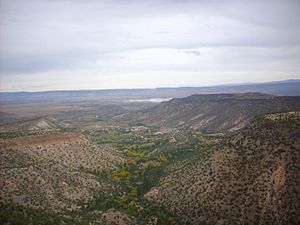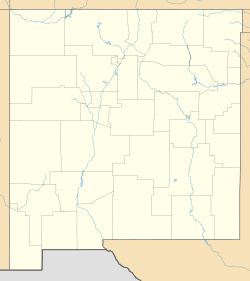Cañones, New Mexico facts for kids
Quick facts for kids
Cañones, New Mexico
|
|
|---|---|
|
Census-designated place
|
|

Cañones seen from Polvadera Mesa
|
|
| Country | United States |
| State | New Mexico |
| County | Rio Arriba |
| Area | |
| • Total | 4.14 sq mi (10.72 km2) |
| • Land | 4.14 sq mi (10.72 km2) |
| • Water | 0.00 sq mi (0.00 km2) |
| Elevation | 7,356 ft (2,242 m) |
| Population
(2020)
|
|
| • Total | 85 |
| • Density | 20.54/sq mi (7.93/km2) |
| Time zone | UTC-7 (Mountain (MST)) |
| • Summer (DST) | UTC-6 (MDT) |
| ZIP code |
87516
|
| Area code(s) | 575 |
| GNIS feature ID | 2584065 |
Cañones is a small community in Rio Arriba County, New Mexico, United States. It is known as a census-designated place, which means it's a special area defined for gathering population data. In 2020, about 85 people lived there. Cañones used to have its own post office, but it closed in 2002.
Contents
History of Cañones
Early Settlement and Ranching
The story of Cañones began in 1766. A man named Juan Pablo Martín Serrano received a large piece of land called the Polvadera Grant. Serrano was a rich military veteran with a big family. He set up a seasonal ranch in the canyon. Here, his family raised animals and grew crops. They also traded with the Ute people.
Permanent homes started to appear later. In 1807, Juan Bautista Valdez bought land where Cañones is today. This marked the beginning of a lasting community.
Studying the Community
In the 1960s, two anthropologists, Paul Kutsche and John R. Van Ness, visited Cañones. Anthropologists are scientists who study human societies and cultures. They thought Cañones was a good example of what they called the Rio Arriba subculture. This was a special way of life for Hispanic people in northern New Mexico.
They found that this subculture had a few key features:
- Communal land grants: Land was often shared by the community.
- Small economies: People mostly relied on local farming and trade.
- Campanilismo: This means a strong sense of community spirit.
- Social equality: People generally had similar social standing.
The School Road Dispute
While Kutsche and Van Ness were visiting, something important happened. The state decided to close the local one-room school. Children were told to go to school in Coyote. This meant students had to ride a bus several miles on a very bad road.
The parents in Cañones refused to send their children to Coyote. They were worried about their children's safety on the rough road. This led to a legal fight. The parents were fined because their children missed school. In the end, the community now has a good paved road.
Ancient Pueblo Ruins Nearby
Just south of Cañones, on Pueblo Mesa, are the ruins of an ancient settlement. It is called Tsiping or Tsi’pinouinge. This place was active between 1200 CE and 1325 CE. At its busiest time, the settlement had many rooms. There were 335 to 400 ground-floor rooms. It also had sixteen kivas, which are special ceremonial rooms. These kivas were built around a central plaza.
Visitors can find the path to these ruins. The trailhead is at the south end of County Road 196.
See also
 In Spanish: Cañones (Nuevo México) para niños
In Spanish: Cañones (Nuevo México) para niños


